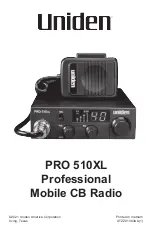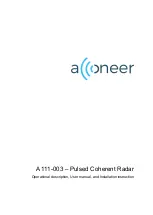
Sheet 2
7
There are two basic types of mobile CB antennas–full-length whips and loaded
whips–with a wide variety of mounts to suit different vehicle locations.
► Choose an antenna that matches the specifications of this radio.
► Follow the manufacturer’s installation instructions carefully.
► Tune your antenna using a Standing-Wave Ratio (SWR) meter: set the
radio to channel 20, and adjust the antenna until the SWR is as close as
1:1 as possible.
CAUTION: Make sure the SWR is
less than 2:1 before using the radio. An
SWR higher than 2:1 can damage the transmitter.
OPERATION AND MAINTENANCE
Basic operation
Turning the
radio on
Turn the
Volume
knob clockwise until the display backlight
comes on.
Turning the
radio off
Turn the
Volume
knob counter-clockwise until it clicks and
the display backlight turns off.
Selecting a
channel
Turn the
Channel
knob clockwise to move up the channel
list. Turn it counter-clockwise to move down the channel list.
Changing the
volume
Turn the
Volume
knob clockwise to increase the volume;
turn it counter-clockwise to decrease the volume.
Transmitting
–
Tune the radio to the channel you want to transmit on, and
listen to make sure the channel is clear.
–
Press and hold the
PTT
button.
–
Hold the microphone about 2 inches away from your mouth
and speak in a normal voice.
–
Release the button to listen for a response.
NOTE: Make sure you read and understood part 95 of the FCC rules and
regulations before using the transmitter.
Emergency operation
1) Press
9/19/NORM
or turn Channel Selector knob to Channel 9.
2) Press
PTT
and speak clearly.
3) If there is no response, select an active channel and ask that party to relay
your emergency broadcast on Channel 9.
All channels except Channel 9 may be used for normal communication.
The FCC reserves Channel 9 for emergencies involving the immediate
safety of individuals or protection of property. Use Channel 9 to render
assistance to a motorist. This is an FCC rule and applies to all CB radio
operators.






























